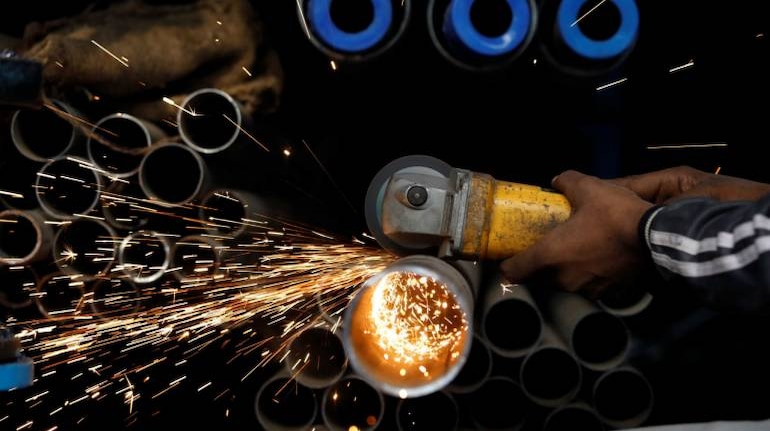



Improvement in the COVID-19 situation, the return to pre-pandemic operation in most sectors of the economy and an uptick in private consumption are among the reasons behind India clocking an 8.4 percent gross domestic product (GDP) growth in the second quarter of financial year 2021-22, say experts.
The acceleration of GDP by 8.5 percent, though lower than the 20.1 percent growth in Q1 FY22, was significantly higher than the contraction of 7.4 percent registered in the pandemic-hit second quarter of last fiscal.
Here's what leading economists have to say:
Aditi Nayar, Chief Economist, ICRA“While the Q2 FY2022 absolute level of real GDP reverted mildly above the pre-Covid level of Q2 FY2020, the disaggregated data for Q2 FY2022 is far from convincing, with considerable lags in private and government consumption expenditure being absorbed by a sharp rise in valuables relative to the pre-Covid level of Q2 FY2020. The 1.5 percent rise in gross fixed capital formation in Q2 FY2022 relative to Q2 FY2020 appears to be the lone silver lining," Nayar said.
"The pace of GVA growth in Q2 FY2022 modestly exceeded our expectations, led by agriculture, forestry and fishing, and public administration, defence and other services. Setting aside these two sub-sectors, GVA recorded a relatively lower YoY growth of 7.5 percent. In particular, the growth of manufacturing, construction and trade, hotels etc. trailed our forecasts, suggesting that rising input costs bit corporate margins, and contact-intensive services continued to trail the pre-Covid levels," she added.
Dharmakirti Joshi, Chief Economist, CRISIL Ltd"Overall Q2 GDP growth was on expected lines. On the demand side, investments (largely government) continued to remain the key growth driver while private consumption is yet to show a decisive recovery. Also, unlike last year, net exports are again a drag on the economy," Joshi said.
Suvodeep Rakshit, Senior Economist, Kotak Institutional Equities"Investment growth remained strong even when compared to Q2 FY20 (pre-Covid) levels. Growth should remain fairly well supported in Q3 FY22 too on account of festive season and opening up of services sector too. Growth remains well on track for a full year growth of around 9.5 percent. The growth numbers will unlikely play a differentiating factor for the RBI’s policy with its own estimate being at 7.9 percent."
"With a new Covid variant starting to spread globally and uncertainty on its impact on the economic scenario, the RBI would possibly wait for some more clarity before moving decisively on the rates. We maintain our call for a reverse repo rate hike in February with the December meeting remaining a close call," Rakshit added.
“The continued vaccine drive led mobility ahead and aid the pick-up in the contact-sensitive services sector has helped in a healthy growth print. Even with YoY moderation to 8.4 percent from 20.1 percent 1Q reflects largely base effect even as sequential momentum has continued to improve. The data affirm that the economy is on continuous mend and will likely be back to pre-pandemic levels before end-FY22," Arora said.
Suman Chowdhury, Chief Analytical Officer, Acuité Ratings & Research“India’s Q2FY22 GDP print has been fairly close to our estimates of 8.4 percent YoY and reflects a healthy recovery in private consumption expenditure driven by an unlock of the economy, declining intensity of the pandemic and the significant progress on vaccination."
"The growth of 9.0 percent in government expenditure over the corresponding period of the previous year has also been an important driver. What is also encouraging to see is a 10.7 percent growth in gross capital formation, driven primarily by public capital expenditure although there are also signs of a pickup in private capex in the current fiscal. The absolute real GDP value has exceeded the pre-pandemic levels of Q2FY20 by 0.33 percent," Chowdhury said.
Rajani Sinha, Chief Economist and National Director - Research, Knight Frank India“The improvement in GDP growth in Q2 FY22 is on expected lines. With increased vaccination and economy moving back to normalcy, most high frequency economic indicators have bounced back above pre-COVID levels. Corporate performance as reflected by quarterly results have also been showing healthy improvement in the economy," Sinha said.
"While consumption has recorded an improvement, a more broad-based consumption recovery would be critical for sustainable and inclusive growth. For that to happen it will be critical for the unorganized sector and the MSME segment to also bounce back quickly."
"The emergence of the new COVID variant has infused uncertainty in the system. If this uncertainty lingers or aggravates, it would adversely impact business and consumer sentiments, with repercussions on the economic growth," Sinha added.
Discover the latest Business News, Sensex, and Nifty updates. Obtain Personal Finance insights, tax queries, and expert opinions on Moneycontrol or download the Moneycontrol App to stay updated!
Find the best of Al News in one place, specially curated for you every weekend.
Stay on top of the latest tech trends and biggest startup news.